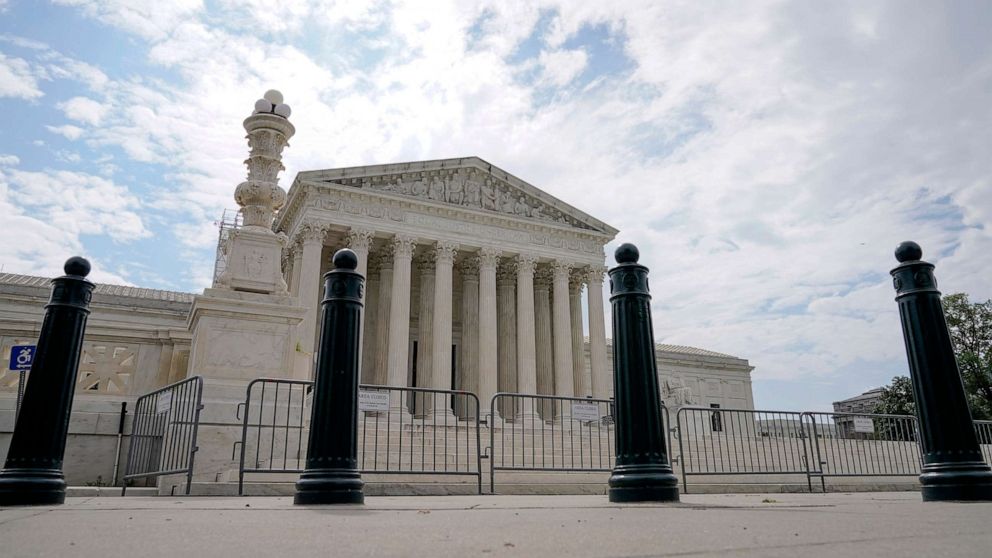周二最高法院推翻了对一名来自科罗拉多州的在线跟踪者的定罪,收紧了在社交媒体上发出的威胁可以作为犯罪受到惩罚的标准。
埃琳娜·卡根法官以7比2的多数写道第一修正案仍然需要证据被告对其言论的威胁性有一些主观理解。"
2016年,科罗拉多州起诉了原告Billy Raymond back man,通过证明back man发送给一名女歌手兼词曲作者的数百条脸书消息客观上具有威胁性,并被受害者以这种方式接收,赢得了州法院的定罪。
他在狱中服刑4年,尽管他一直坚称自己从未打算威胁音乐家科尔斯·惠伦。
“国家必须证明被告有意识地忽视了他的通信会被视为暴力威胁的重大风险,”卡根写道。
她写道,州政府没有证明意图或精神状态的证据“违反了第一修正案”。
在她网站上的一份声明中,Whalen写道,“我很失望最高法院的决定已经最小化了跟踪和威胁对受害者及其家人造成的伤害。如果你害怕,请相信自己,伸出援手。法院的判决并不意味着受害者必须独立。”
“发给我的数千条不稳定信息威胁着我的生命,改变着我的生活,”她写道。
艾米·科尼·巴雷特和克拉伦斯·托马斯法官不同意。
巴雷特写道:“这名助理传达了真实的威胁,每个人都同意,这超出了第一修正案的保护范围。”。”他知道这句话是什么意思。这些威胁导致受害者对自己的生命感到恐惧,并颠覆了她的日常生活。尽管如此,法院的结论是,反诉可以在第一修正案辩护中占上风。《宪法》中没有任何内容强制规定这一结果。”
支持阿科曼案件的法律学者表示,这一决定加强了言论自由保护,减少了“误解定罪”的可能性——正如阿科曼的律师在以前的法庭文件中所说。
然而,该裁决的批评者警告说,在威胁行为猖獗的时候,这将使执法部门更难保护网上的人。

美国最高法院,2023年6月27日,华盛顿。
Mariam Zuhaib/AP
科罗拉多州总检察长菲尔·魏泽今年早些时候在接受美国广播公司新闻采访时说:“跟踪者往往无视现实,如果你要求州政府必须证明他们明白他们的话是威胁性的,并造成了对身体暴力的恐惧,你实际上可能会让很多跟踪者离开。”。
卡根代表法院的大多数成员承认这些担忧,但她在周二的意见书中写道,新标准不会牺牲“针对真正的威胁实施法律的太多好处。”
“我们今天采用的规则既不是最能保护言论的,也不是对真正威胁的危险最敏感的,”她写道。这种平衡保留了“天平两边的大部分重要内容。”
Supreme Court overturns online stalking conviction, citing 1st Amendment
The Supreme Court on Tuesdayoverturned the conviction of an online stalker from Colorado, tightening the standard by which threats made on social media can be punished as crimes.
Justice Elena Kagan, writing for a 7-2 majority, said the "the First Amendment still requires proofthat the defendant had some subjective understanding of the threatening nature of his statements."
In 2016, Colorado prosecuted the plaintiff, Billy Raymond Counterman, winning a state court conviction by showing that hundreds of Facebook messages Counterman sent to a female singer-songwriter were objectively threatening and received that way by the victim.
He served 4½ years behind bars, even though he has always maintained that he never intended to threaten the musician, Coles Whalen.
"The state must show that the defendant consciously disregarded a substantial risk that his communications would be viewed as threatening violence," Kagan wrote.
That the state did not prove evidence of intent or state of mind "is a violation of the First Amendment," she wrote.
In a statement on her website, Whalen wrote, in part, "I’m disappointed that the Supreme Court’s decision has minimized the harm that stalking and threatening causes to victims and their families. If you are afraid, please trust yourself and reach out for help. The Court’s decision does not mean that victims must stand alone."
"The thousands of unstable messages sent to me were life threatening and life altering," she wrote.
Justices Amy Coney Barrett and Clarence Thomas dissented.
"Counterman communicated true threats, which, everyone agrees, lie outside the bounces of the First Amendment protection," Barrett wrote. "He knew what the words meant. Those threats caused the victim to fear for her life, and they upended her daily existence. Nonetheless, the court concludes that Counterman can prevail on a First Amendment defense. Nothing in the Constitution compels that result."
Legal scholars supportive of Counterman's case say the decision bolsters free speech protections and reduces the chance of "criminalizing misunderstandings" -- as Counterman's attorneys put it in previous court documents.
Critics of the ruling, however, warn it will make it more difficult for law enforcement to protect people online at a time when threatening behavior is rampant.
"Stalkers are often oblivious to reality, and if you require the state to have to show that they understood that their words were threatening and creating this fear of physical violence, you could actually let a lot of stalkers go," Colorado Attorney General Phil Weiser said in an interview with ABC News earlier this year.
Kagan acknowledged those concerns on behalf of the court's majority, but wrote in her opinion on Tuesday that the new standard would not sacrifice "too many of the benefits of enforcing laws against true threats."
"The rule we adopt today is neither the most speech-protective nor the most sensitive to the dangers of true threats," she wrote. The balance keeps "much of what is important on both sides of the scale."






